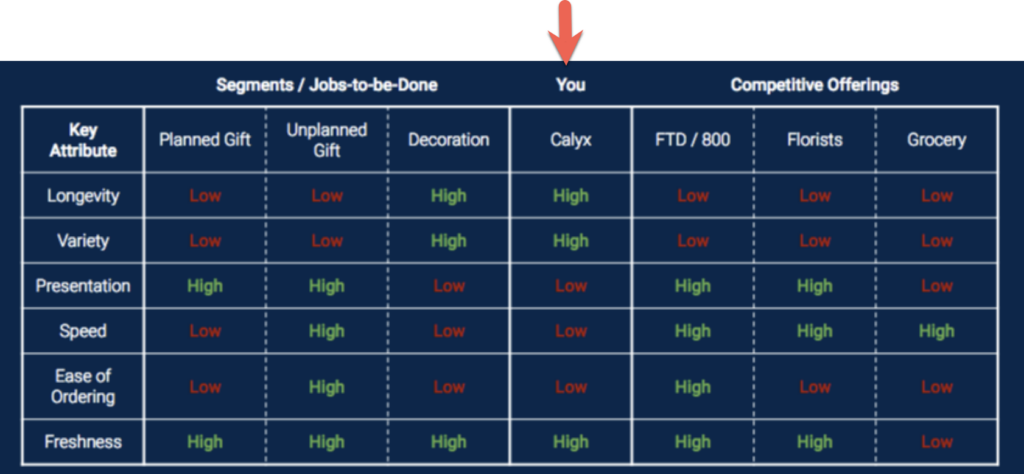As an early stage founder, how can you identify your customer segments

As a founder, you are looking for your ICP, Ideal Customer Profile within a customer segment. Choosing an ICP is a daunting task and can take some time to determine in the early stages.
This is even assuming you have figured out your customer segment. In your market, there can be multiple customer segments and when you are starting out, it can be hard to determine which is the right one.
In my work as advisor, I work with many B2B founders on which customer segments to focus on. Finding the right segment when you are starting out is critical. Especially, when you have to start in a small niche.
So how how you do determine the right customer segment.
The normal process is to rely on traditional segmentation methods like demographics (age, location) or firmographics (company size, industry), but these often fail to capture what truly matters : why customers buy in the first place.
This is where Jobs-to-Be-Done (JTBD) comes in.
Instead of grouping customers by surface-level characteristics, JTBD focuses on their underlying motivations—the “job” they’re hiring a product to do. By understanding these jobs, startups can segment customers in a way that drives product adoption, messaging, and growth.
What is Jobs-to-Be-Done (JTBD)?
The JTBD framework shifts the focus from who the customer is to what they are trying to accomplish. Customers don’t just buy products; they “hire” them to solve specific problems.
Clayton Christensen, who popularized JTBD, gave a famous example: People don’t buy a drill because they want a drill; they buy it because they need a hole in the wall. The drill is just a means to an end.
JTBD’s main purpose is to design the right products for users such that it helps them solve their key problems and make them effective. But you can also use it for identifying your segments.
Using JTBD to Identify Segments: The Flower Delivery Example
In my coaching sessions at UC Berkeley, we use the example of a flower delivery service. Imaging you are a flower delivery service provider. On the surface, it seems simple. You deliver flowers. It’s a horizontal solution and anyone can use it, right?
Let’s break it down a bit more.
Typically, you might break your segments by age group or gender like Males 20-25 or High income professionals in a big city.
By segmenting solely on demographic etc, you miss out on the key nuances of your product design and go to market.
Instead of segmenting by age, gender, or location, let’s segment based on the job the customer is trying to accomplish.
What are main jobs of a person who needs flowers?
There are many context for which you need flowers.
Planned gift – A person knows that they need flowers on a specific date e.g. a wedding, milestone birthday, graduation.
Unplanned gift – A person needs flowers at the last minute.
Decoration – A person may want to decorate their house with exotic flowers, or a company may want to decorate their reception or board rooms with flowers. Hotels, hospitals, conference caterers will all fall into these range.
Cultural – Flowers can be used for cultural occasions such as weddings or religious festivals. Let’s consider these as decoration too.
Now that we have determined the cluster of segments, we identify the attributes that make these segments different
1. Planned Gift (Celebratory & Thoughtful Gifting)
Customers in this segment are proactively ordering flowers for a specific occasion. The decision-making is deliberate, and they prioritize quality and presentation.
Key Attributes:
✅ Event-driven: Birthdays, anniversaries, Valentine’s Day, Mother’s Day
✅ Lead time: Ordered days or weeks in advance
✅ Product: Premium fresh flowers in specific genre e.g. roses, elegant arrangements, personalization (cards, messages), longevity is not important.
✅ Customer mindset: “I want to make this moment special and memorable.”
2. Unplanned Gift (Last-Minute & Apology Flowers)
These customers make impulse purchases—usually to recover from a mistake or express spontaneous emotions. Speed matters more than selection.
Key Attributes:
✅ Occasion-driven: Apologies, “just because,” last-minute birthdays
✅ Lead time: Immediate or same-day delivery
✅ Product: Speed, convenience, reliable availability, longevity or variety are not important
✅ Customer mindset: “I need flowers, fast, and they need to look great.”
3. Decoration (Enhancing Spaces & Ambiance)
This segment is not about gifting but rather about aesthetics. The flowers serve a functional role in beautifying homes, offices, or events.
Key Attributes
✅ Use case-driven: Home décor, office lobbies, conference rooms, event styling, hotels, hospitals
✅ Lead time: Regular or bulk orders
✅ Product: Longevity, cost-effectiveness, style variety, managed services to decorate and remove old flowers
✅ Customer mindset: “I want fresh flowers that elevate our space without hassles of ordering, arranging or getting rid of wilted flowers”
Now that you have your segments defined, ask yourself which segment is most suited for your product or service based on your unique strengths. Check the competition and see where they fit into these attributes. Find underserved areas and then focus on that initial segment.
For example, let’s say your unique strength is you have access to a variety of exotic flowers and vendors and you have the ability to scale procurement. Maybe the decoration market is a good fit for you.
Or let’s say you have strong base of customers who order online for rushed orders, then perhaps you can make a niche in the unplanned gifting segment.
Here is summary of the flower example.

Credit: PM Studio program at UC Berkeley.
Why This Matters for Founders
Instead of targeting “Men buying flowers” or “People aged 25-45”, you now have three distinct customer segmentsbased on real needs.
This leads to :
📌 Better Messaging: Speak directly to the job (e.g., “Never forget an anniversary” vs. “Flowers for every occasion”).
📌 Stronger Product Fit: Tailor offerings to each job’s priorities.
📌 Smarter Growth Strategies: Run targeted campaigns (e.g., retarget past “Apology” buyers for last-minute occasions).
By shifting your focus from who customers are to why they buy, you unlock a more strategic and effective approach to segmentation.
What’s the process of going about with the technique?
1. Conduct Customer Interviews
Start by talking to customers (or potential customers) to uncover patterns in their decision-making process. Key questions to ask:
“What problem were you trying to solve when you looked for a solution like this?”
“What alternatives did you consider before choosing this product?”
“How do you measure success when using a product like this?”
“What is the context of when the job was needed to be done”
These insights help identify the real jobs customers are hiring your product for.
2. Map Out Key Jobs-to-Be-Done
JTBD can be broken into three categories:
Functional jobs – The core task the customer needs to complete (e.g., “automate reporting”).
Emotional jobs – The way the customer wants to feel (e.g., “feel in control of my data”).
Social jobs – How the customer wants to be perceived (e.g., “be seen as a data-driven leader”).
Understanding all three allows for a more nuanced segmentation strategy.
3. Cluster Customers by Jobs, Not by Demographics
Once you identify key jobs, group customers by similar jobs rather than traditional attributes.
For example, a small startup founder and a VP at a large enterprise might both be looking for a tool to generate sales leads. Even though they’re from different company sizes, their core job is the same. This approach prevents false segmentation based on factors that don’t actually influence buying decisions.
In our flower example above, there are many sub segments that plan a flower delivery – valentines day, birthday, wedding, occasions, award ceremonies etc. They all have similar needs and we cluster them as “Planned Gifts”.
4. Validate with Data
After defining segments based on jobs, back it up with behavioral data. Look at:
Is the demand real? Is it big enough?
Which jobs drive retention? Are certain jobs leading to longer-term customers?
Is there a willingness to pay?
What If You Don’t Have Existing Customers? (For Early-Stage Startups)
If you’re just starting out and don’t have customer data, you can still apply JTBD by gathering insights in other ways:
Talk to potential customers – Engage in problem-discovery conversations. Ask, “What’s your biggest challenge with X ?”
Analyze online conversations – Look at LinkedIn, Reddit, Twitter, and industry forums where people discuss their pain points.
Study competitor reviews – Read G2, Capterra, or App Store reviews to identify recurring themes around why people buy (or leave) similar products.
Run a landing page test – Create different versions of your messaging based on potential jobs-to-be-done and see which resonates most.
Leverage industry experts – Speak with advisors or domain experts who deeply understand your target audience.
These methods can help validate which jobs exist in your market before you even have customers.
Real-World Example
Let’s say you’re building a B2B SaaS tool for sales automation. Instead of segmenting customers by company size or job title, you use JTBD to identify their key jobs:
Job 1: “Automate manual lead generation.”
Job 2: “Improve outbound response rates with personalization.”
Job 3: “Standardize sales workflows across global teams.”
Now, your product roadmap, messaging, and GTM strategy are aligned to serve one or more of these distinct jobs rather than making assumptions based on traditional segmentation like SMB vs Enterprises.
Applying JTBD Segments to Growth Strategy
Once you’ve identified your JTBD-driven segments, apply them across your business:
Marketing & Positioning – Craft messaging that speaks directly to each job segment.
Sales & Onboarding – Personalize demos and onboarding flows based on customer jobs.
Product Roadmap – Prioritize features that solve the most critical jobs.
By aligning everything around the why behind customer decisions, startups can acquire and retain customers more effectively.
Conclusion
Traditional segmentation methods often fail because they focus on who customers are rather than what they need. By shifting to a Jobs-to-Be-Done framework, startups can define segments based on real customer motivations, leading to better positioning, higher retention, and stronger growth.
If you’re a founder, start by talking to potential customers, identifying their jobs, and grouping them accordingly. The sooner you understand the “why” behind customer decisions, the faster you can build something people truly need.

